| 1 |
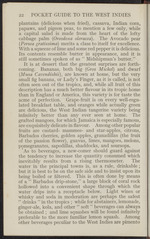 |
“...safe side and to insist upon its
being boiled or filtered. This is often done by means
of a “ Barbados drip-stone,” a large block of coral rock
hollowed into a convenient shape through which the
water drips into a receptacle below. Light wines or
whisky and soda in moderation are perhaps the safest
“ drinks ” in the tropics ; while for abstainers, lemonade,
ginger-ale, kola, and other " soft ” beverages can always
be obtained ; and lime squashes will be found infinitely
preferable to the more familiar lemon squash. Among
other beverages peculiar to the West Indies are pimento...”
|
|
| 2 |
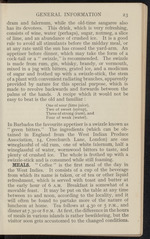 |
“...dinner, which may take the form of a
cock-tail or a “ swizzle,” is recommended. The swizzle
is made from rum, gin, whisky, brandy, or vermouth,
mixed in a jug with bitters, grated ice, and a modicum
of sugar and frothed up with a swizzle-stick, the stem
of a plant with convenient radiating branches, apparently
provided by nature for this special purpose, which is
made to revolve backwards and forwards between the
palms of the hands. A recipe which it would not be
easy to beat is the old and familiar :
One of sour (lime juice),
Two of sweet (syrup),
Three of strong (rum), and
Four of weak (water).
In Barbados the favourite appetiser is a swizzle known as
“ green bitters.” The ingredients (which can be ob-
tained in England from the West Indian Produce
Association, 14, Creechurch Lane, London) are one
wineglassful of old rum, one of white falemum, half a
wineglassful of water, wormwood bitters to taste, and
plenty of crushed ice. The whole is frothed up with a
swizzle-stick and is consumed...”
|
|
| 3 |
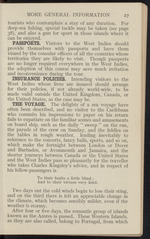 |
“...adoption of this course may save much irritation
and inconvenience during the tour.
INSURANCE POLICIES. Intending visitors to the
West Indies whose lives are insured should arrange
for their policies, if not already world-wide, to be
made valid outside the United Kingdom, Canada, or
the United States, as the case may be.
THE VOYAGE. The delights of a sea voyage have
often been described, and no visitor to the Caribbean
who commits his impressions to paper on his return
fails to expatiate on the familiar scenes and amusements
on board ship, such as the daily “ sweep ” on the run,
the parade of the crew on Sunday, and the fiddles on
the tables in rough weather, leading inevitably to
reference to the concerts, fancy balls, sports, and so on,
which make the fortnight between London or Dover
and Barbados, or Avonmouth and Jamaica, and the
shorter journeys between Canada or the United States
and the West Indies pass so pleasantly for the traveller
who takes Charles Kingsley’s advice, and in respect...”
|
|
| 4 |
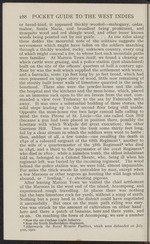 |
“...WEST INDIES
or bread-kind, it appeared thickly wooded—mahogany, cedar,
mahoe, Santa Maria, and broadleaf being prominent, and
mosquito wood and red shingle wood, and other lesser known
woods being pointed out by our guide. ... As one rides along
these defiles the mournful note of the solitaire suggests the
nervousness which might have fallen on the soldiers marching
through a thickly wooded, rocky, unknown country, every crag
of which might conceal a foe, to whose foot such mountain paths
were familiar. At Maroon Town itself, we found a clearing on
which cattle were grazing, and a police station (just abandoned)
built on the site of the officers’ quarters of half a century ago.
Near by was the well which supplied the settlement with water,
and a barracks, some 130 feet long by 30 feet broad, which had
once possessed an upper story of wood, little now remaining of
the stoutly built lower walls of limestone quarried in the neigh-
bourhood. There also were the powder-house and the cells,
the...”
|
|
| 5 |
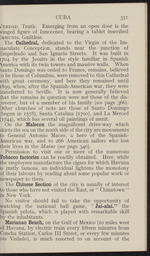 |
“...CUBA
351
/erdad, Truth. Emerging from an open door is the
«ringed figure of Innocence, bearing a tablet inscribed
[mmunis, Guiltless.
The Cathedral, dedicated to the Virgin of the Im-
naculate Conception, stands near the junction of
Empedrado and San Ignacio Streets. It was built in
[704 by the Jesuits in the style familiar in Spanish
\merica with its twin towers and massive walls. When
Santo Domingo was ceded to France, remains, believed
to be those of Columbus, were removed to this Cathedral
with great ceremony, and here they remained until
1899, when, after the Spanish-American war, they were
transferred to Seville. It is now generally believed
that the remains in question were not those of the dis-
coverer, but of a member of his family (see page 366).
Other churches of note are those of Santo Domingo
(begun in 1578), Santa Catalina (1700), and La Merced
(1744), which has several oil paintings of merit.
On the Malecon the magnificent drive-way which
skirts the sea on the north side...”
|
|
| 6 |
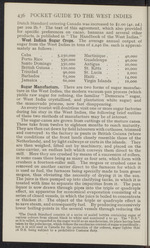 |
“...$1.00 (4s. 2d.)
per 100 lb.1 The text of this agreement, which also provided
for specific preferences on cacao, bananas and several other
products, is published in " The Handbook of the West Indies.”
West Indian Sugar Crops. The average annual output of
sugar from the West Indies in tons of 2,240 lbs. each is approxi-
mately as follows :
Cuba
Porto Rico
Santo Domingo
British Guiana .
Trinidad .
Barbados
Jamaica .
----------9 — ■ — - ' — . JL^JL OOCOO iniUVU
yields raw sugar for refining, the familiar “ Demerara " sugar,
or West India crystallised, and plantation white sugar) and
the muscovado process, now fast disappearing.
As every tourist will doubtless visit one or more sugar factories
during his stay in the West Indies, the following brief outline
of these two methods of manufacture may be of interest.
The sugar-canes are grown from cuttings of the mature canes.
These take from twelve to eighteen months to reach maturity.
They are then cut down by field labourers with cutlasses, trimmed...”
|
|
| 7 |
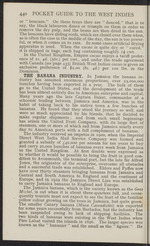 |
“...enterprise, overcame all obstacles
and a successful trade was established. Elders and Fyffes now
have over thirty steamers bringing bananas from Jamaica and
Central and South America to England and the continent of
Europe, and in 1929 the Jamaica Direct Line was established
to carry Jamaica bananas to England and Europe.
The Jamaica banana, which is the variety known as the Gros
Michel, is cut when it is about three-quarters full, and conse-
quently tourists must not expect to see the fruit of the familiar
yellow colour growing on the trees in Jamaica, but quite green.
The smaller Canary banana (Musa Cavendishii) was exported ;
for some years successfully from Barbados, but the industry has
been suspended owing to lack of shipping facilities. The
two kinds of bananas were existing in the West Indies when
Père Labat visited the islands in 1696. The larger species was i
known as the " bananier ** and the small as the “ figuier.'* He...”
|
|
